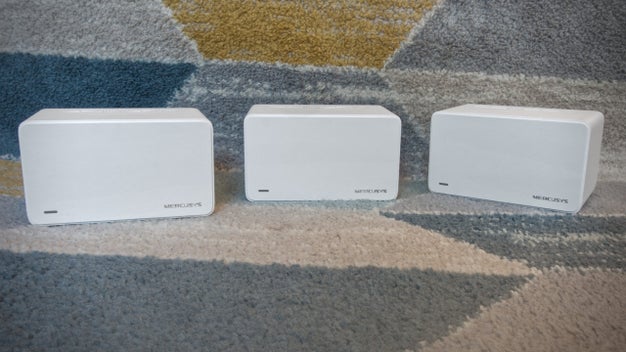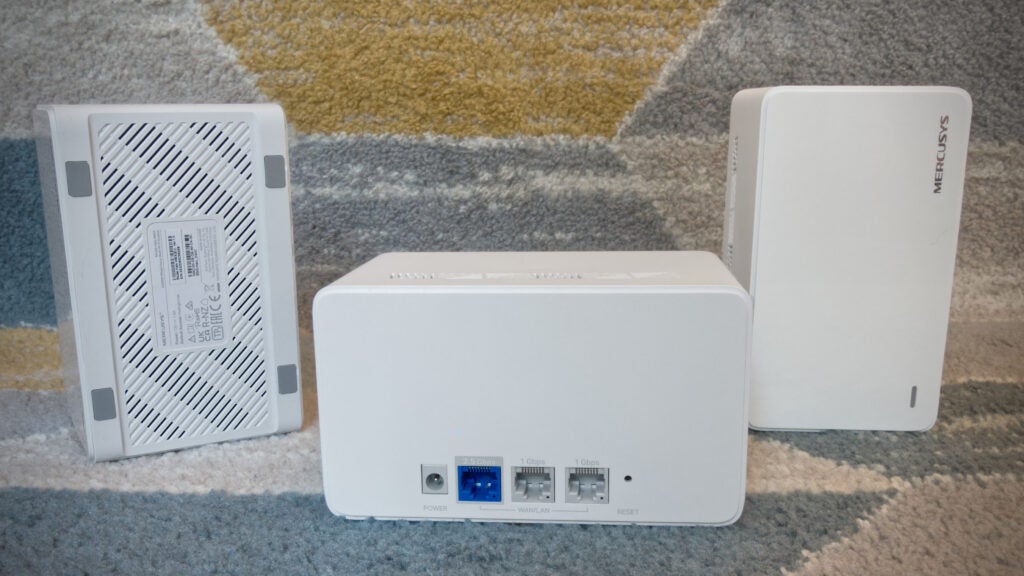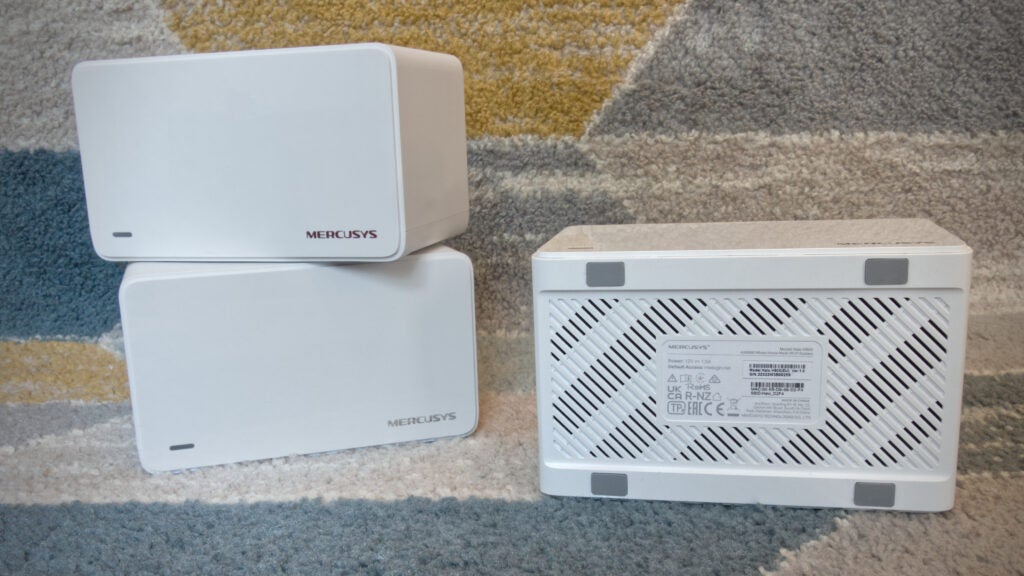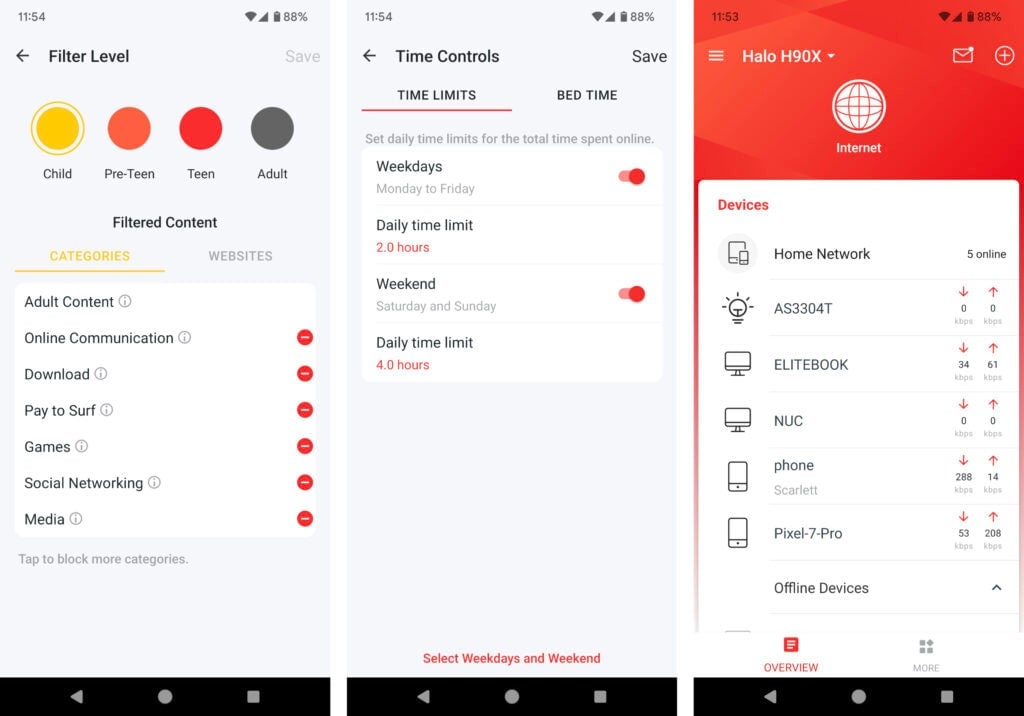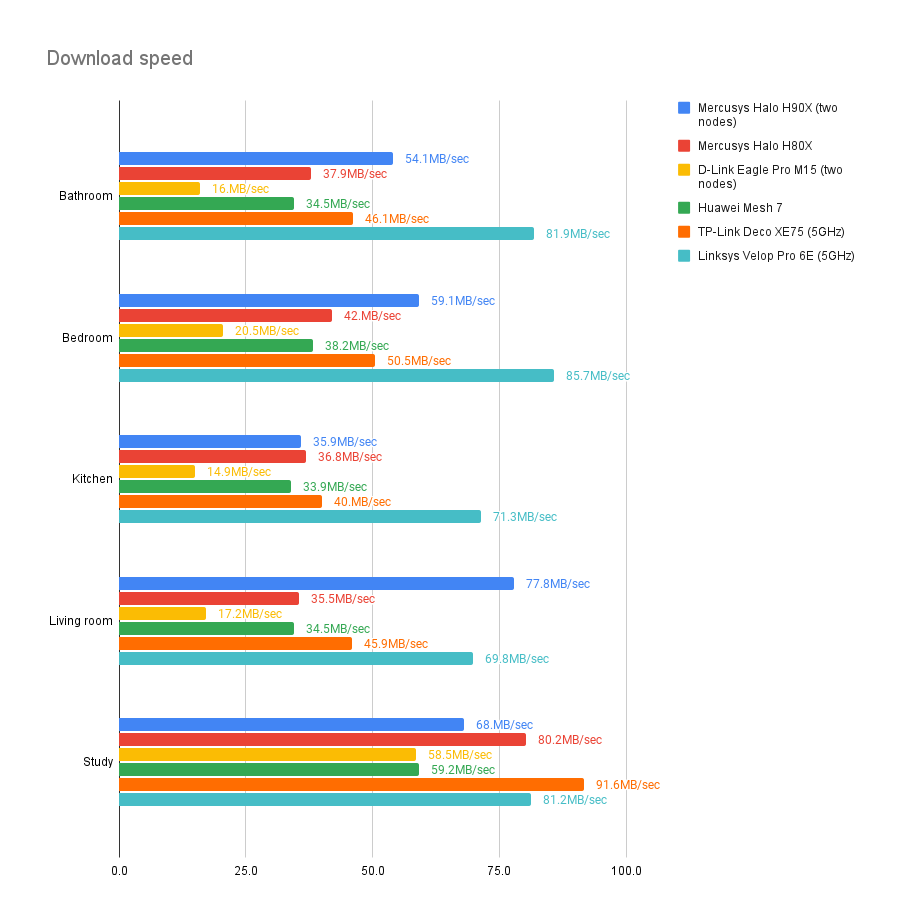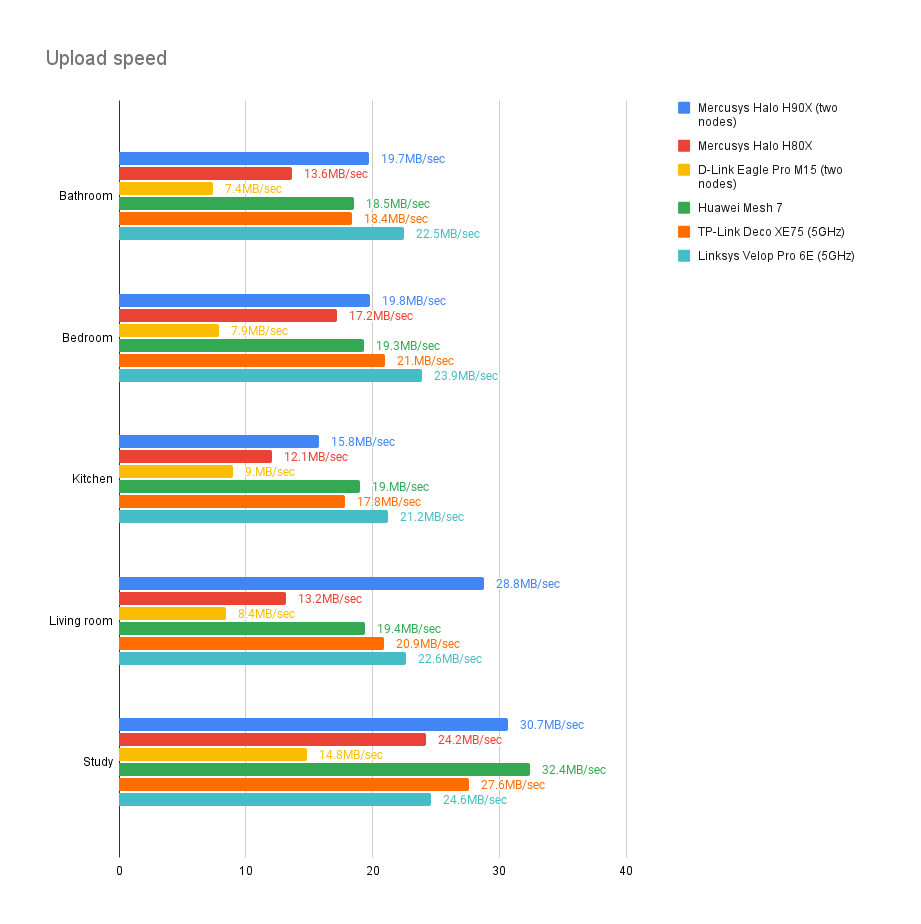Mercusys’ new mesh is its fastest yet, but it doesn’t greatly stand out from similarly priced rivalsd
We loved Mercusys’ debut mesh, the Mercusys Halo H80X. It didn’t break any new technological ground, but it served up strong wide-area Wi-Fi 6 coverage for a terrific price. Now comes the Mercusys Halo H90X AX6000), an upgraded sibling promising double the Wi-Fi speed on both the 2.4GHz and 5GHz bands.
In reality, you won’t see a doubling of your download rates in daily use, but the H90X does deliver a speed boost for individual clients. It can also provide a smoother service when multiple devices are accessing the network at once.
Unlike the H80X, however, the H90X isn’t exactly a bargain. Its launch price pits it against several established rival meshes, most of which have the advantage of Wi-Fi 6E. If you’re looking for top performance, therefore, the H90X isn’t necessarily an obvious choice – although you might still be won over by its distinctive personality and hardware design.
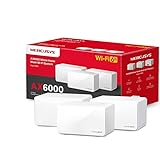
Mercusys Halo H90X (AX6000), three pack
£239.99 Check price 
Mercusys Halo H90X review: What you need to know
The Halo H90X comes as a package of either two or three boxy white stations: Mercusys claims the former will cover an area of up to 550m2, while the extra unit boosts the maximum coverage area to 800m2. As always, the actual performance you see will depend on the layout and construction of your home.
Inside each unit there’s a 2.4GHz radio rated at 1,148Mbits/sec, and a 5GHz radio supporting connection speeds of up to 4.8Gbits/sec. Those are the fastest speeds you’ll find on any consumer Wi-Fi mesh, and each unit also has a 2.5Gbits/sec Ethernet connector, along with two regular gigabit sockets.
It’s a solid specification, but a few things are missing. For one, the system is purely a dual-band design, with no dedicated radio link for backhaul traffic. That’s unusual at this price: it means your client connections have to share bandwidth with packets being forwarded back and forth between the Halo stations. Officially, the system can handle up to 150 devices, but if there’s lots of network activity going on, your bandwidth is going to get eaten up more quickly than it would with a tri-band system.
With only two radios there’s also, naturally, no support for the 6GHz frequency band, so this mesh won’t be able to get the best from the latest Wi-Fi 6E-enabled devices.
Mercusys Halo H90X review: Price and competition
Mercusys is a sub-brand of TP-Link, and from the company’s first few releases we thought it was going to focus on low-cost networking gear. The Halo H90X, however, isn’t exactly a low-cost system: you’ll pay £340 for a twin-pack, or £483 for a set of three units. We’re in a totally different ballpark to the original H80X, which currently sells on Amazon at £95 for two stations or £135 for three.
For basic home networking, the H80X remains our top value choice; alternatively, for a similar price you could opt for the D-Link M15 Eagle Pro AI AX1500. That system lags well behind the Mercusys for performance, but it does include a simple firewall and an integrated VPN server, which the Halo systems lack.
If you’re looking to invest in a bit more performance, there are several tri-band systems available at similar prices to the Halo H90X. The Huawei Mesh 7 comes as a set of two stations for £330 (B0B7NXWPGL), while TP-Link’s own Deco XE75 adds 6E support, and is currently on offer at just £340 for three units.
Another tempting offer in this price range is the Linksys Velop Pro 6E. This again adds a 6GHz radio, which handles both backhaul duties and Wi-Fi 6E client connections, and as we’ll see below, this enables some very strong performance. The price, meanwhile, isn’t much different to the Halo H90X, coming in at £380 for two stations or £500 for three.
For those seeking the fastest possible downloads, the TP-Link Deco XE200 offers exceptional performance and massive reach, with Wi-Fi 6E and 10-gigabit Ethernet – but it’ll cost you £620 for two units. And at the top of the pile, Netgear’s aspirational Orbi RBKE963 system takes the crown for 6GHz performance, but considering it costs £1,200 for two units, or £1,700 for three, it jolly well ought to.

Mercusys Halo H90X (AX6000), three pack
£239.99 Check price 
Mercusys Halo H90X review: Design and features
The Halo H90X units look a lot like the old H80X ones, although they’re a little larger in every dimension, measuring 150 x 94 x 87mm. On the front, a tasteful LED strip glows red, blue, yellow or white to show each station’s status; at the rear, there’s a power socket, three Ethernet ports (the blue one supports 2.5GbE, and can support either LAN or WAN connections) and a pinhole reset button. That’s all there is to see, except for a simple venting pattern along the top – and that’s fine by me. In all, the units are neat and tasteful enough to blend happily into almost any home.
Setup is quick and easy with the Mercusys mobile app. The Android version almost instantly located our first Halo node, prompted us to enter a new network name and passphrase, and rebooted the unit to apply the new settings. We were then prompted to plug in our other Halo stations, which automatically picked up our settings, and the new network was fully functional in under five minutes.
Ongoing administration is carried out in the same app. It’s quite straightforward to check the state of your stations, adjust your wireless settings, set priority clients, configure DHCP and port forwarding settings and so forth. There’s also a set of built-in parental controls, which are pretty versatile for a freebie. As well as setting per-device time limits and schedules, you can block a variety of website categories, and block specific URLs.
What the Halo firmware doesn’t include is any network security features (TP-Link’s HomeShield service is limited to its Archer routers and Deco meshes), nor any sort of VPN support. That was easy to overlook on the cheap-as-chips H80X, but it feels mean on this much more expensive system.
If you don’t get on with apps, you can also bring up a web console, but as with TP-Link’s own-brand routers and meshes this is mostly informational. You can browse a network map and check your connection details, but only a few low-level functions can be accessed from here, such as setting the time or updating the firmware.
Mercusys Halo H90X review: Performance
On paper the Halo H90X’s 4.8Gbits/sec maximum connection speed is twice as fast as the older H80X. However, this change in the specification is solely down to a doubling of the system’s MIMO capabilities, from 2×2 to 4×4. Since most consumer devices are limited to 2×2 MIMO, you wouldn’t necessarily expect individual laptops and smartphones to see any advantage from this change.
To find out how the H90X performs in real-world use, I tested the system in my usual way, using an HP Elitebook Dragonfly laptop equipped with an Intel AX200 2×2 Wi-Fi 6 card. I took this to various areas of my home, connected it to the 5GHz Halo network and measured average read and write speeds when copying files to and from an Asustor AS3304T Drivestor NAS (connected to the primary Halo unit by 2.5GbE).
The speeds I saw are shown in the graph below, along with comparable results for the Halo H80X and the other mesh systems mentioned previously. I carried out my tests twice with the H90X system, once using a two-node configuration and once with three stations spread around my home, but I saw no significant difference in the results – evidently two Halo units are enough to fully cover my split-level, three-bedroom maisonette. For clarity, therefore, I’ve focused on two-node performance:
There’s no doubt about it, even with a single 2×2 client the new mesh is faster than the H80X. I saw a dip in performance in the kitchen, and a big uptick in the living room, but overall the Halo H90X delivered excellent speeds throughout my home.
It even measured up favourably against the tri-band Huawei Mesh 7 and TP-Link Deco XE75 systems, with faster download speeds in almost all locations. The Mercusys couldn’t keep up with the Linksys Velop Pro 6E, but it’s still an impressive set of results for a dual-band mesh.
This very respectable showing may have something to do with the H90X’s improved antenna array, compared to the H80X. The slightly larger casing allows for a larger aerial assembly, and Mercusys claims that the H90X has improved overall reception sensitivity.
What’s more, this test doesn’t reveal the full performance potential of the Halo H90X, because it only uses a single client. With twice the MIMO capacity of the H80X, the H90X ought to really shine when multiple devices are reading and writing data at once. Unfortunately, testing multi-client performance isn’t quite as simple as firing up our standard test on two laptops at the same time, as trying to read and write multiple files at once is liable to cause slowdowns at the NAS.
To measure the multi-client capabilities of the H90X I therefore turned to Totusoft’s LAN Speed Test tool, with the optional server component which stores test data in RAM on a target Windows system. This means its results don’t perfectly reflect real-world performance, and aren’t directly comparable to the results of our NAS-based file-copy tests – but it also means that any potential effects of storage latency and caching are removed from the equation.
To ensure a fair comparison between systems I dug out the original Halo H80X and tested it in exactly the same way as the H90X. Both meshes were set up in a two-node configuration, with my server PC connected to the primary Halo unit via Ethernet. I then tested read and write speeds in all of my usual test locations using two laptops simultaneously – the first, my usual HP Elitebook Dragonfly, the second a Dell Inspiron 7610 equipped with the same Wi-Fi card. Here’s what I saw:
| Halo H80X | Halo H90X | |||||
| MB/sec | Laptop 1 | Laptop 2 | TOTAL | Laptop 1 | Laptop 2 | TOTAL |
| Bathroom download | 11.8 | 10.2 | 22 | 16.1 | 15.1 | 31.2 |
| Bedroom download | 12.7 | 11.9 | 24.6 | 18.4 | 17.8 | 36.2 |
| Kitchen download | 16.2 | 10 | 26.2 | 28.5 | 21 | 49.5 |
| Living room download | 23.2 | 20.1 | 43.3 | 33.5 | 30.3 | 63.8 |
| Study download | 13.6 | 23.3 | 36.9 | 34 | 31.2 | 65.2 |
| Bathroom upload | 15.5 | 15.4 | 30.9 | 26.2 | 21 | 47.2 |
| Bedroom upload | 34.9 | 18.3 | 53.2 | 38.5 | 37 | 75.5 |
| Kitchen upload | 14.7 | 8.2 | 22.9 | 24 | 26.9 | 50.9 |
| Living room upload | 24.9 | 33.5 | 58.4 | 56.2 | 66.4 | 122.6 |
| Study upload | 31.9 | 51 | 82.9 | 65.3 | 74.8 | 140.1 |
While the H90X still didn’t provide double the total throughput of the H80X, it gave both laptops a significantly faster connection. In an age when our homes are filling up with connected devices, that’s an attractive capability.
The H90X’s enhanced MIMO capabilities also mean it has more backhaul capacity between mesh stations, which doubtless helps it compete with tri-band systems.
However, that’s not enough to really boost the H90X into the Champions League of meshes. The similarly priced Velop Pro 6E delivered faster downloads than the Halo H90X’s download speeds in every location, while the premium-priced TP-Link Deco XE200 and Netgear Orbi RBKE963 systems remain way out ahead of the pack.

Mercusys Halo H90X (AX6000), three pack
£239.99 Check price 
Mercusys Halo H90X review: Should you buy it?
The Halo H90X has many of the same appealing qualities as its cheaper sibling. The units are pleasingly simple and compact, wireless coverage is excellent, and administration is a breeze.
The H90X also has a clear bandwidth advantage. If you have lots of devices all wanting to share a fast internet connection at the same time, or move big files around over your LAN, this mesh will keep everything moving more smoothly than its cheaper relative.
Unfortunately, where the Halo H80X delighted us with its cheapness, the H90X doesn’t feel like such a great deal. It’s a little short on software features compared to other meshes in its price range, and it can’t keep up with the 6GHz-enabled Linksys Velop Pro 6E – although the H90X does have the advantage of 2.5GbE and, arguably, a more user-friendly management app.
In short, if you’re settled on a mesh in the £300+ price range, you’ll have to weigh up carefully whether this is the right one for you. And if you’re looking for value, it almost certainly isn’t: the basic H80X costs a third as much as the H90X and is still fast enough to nearly max out a 500Mbits/sec fibre line. For most households, that’s all you’re likely to need for many years to come.

